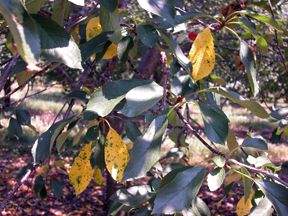Appearance of a virus disease of tart cherry in northwest Michigan
Editor’s note: This article is from the archives of the MSU Crop Advisory Team Alerts. Check the label of any pesticide referenced to ensure your use is included.
Growers in northwest Michigan have been noticing many yellowing leaves in their tart cherry orchards. Most have assumed that the yellow is caused by cherry leaf spot (CLS), which indeed has been showing up in the region’s orchards over the past week. However, on closer inspection, there are no CLS lesions on the leaves. At this time, we suspect that we are seeing green ring mottle virus (GRMV) in some orchards while in others we believe the yellowing his caused by cherry yellows virus. The GRMV diagnosis is awaiting confirmation by laboratory testing to be conducted at Washington State University. It is also possible that the symptoms we are observing may be caused by aberrant forms of more common viruses. We will be able to sort out this uncertainty when the diagnosis is complete.
Symptoms of GRMV infection are usually expressed in late June to mid-July. The main symptom of GRMV infection is bright yellow leaves with circular green blotches (see photo). These infected leaves can be easily removed from trees during shaking at harvest or will defoliate naturally. Severe cases of GRMV can result in a loss of 40-50 percent of the leaves on a tree. In northwest Michigan, GRMV symptoms have been appearing sporadically (one to a few infected trees per block), but often significant levels of defoliation are associated with the disease. Sometimes fruit is affected by GRMV and will look indented with streaks of dead tissue to the pit. Natural spread of GRMV is very slow and appears to occur tree-to-tree via root grafts. The virus is also spread by grafting at the nursery stage. Indeed, with virus indexing capabilities nurseries employ, we should not be seeing this disease in virus-free nursery stock.
There is no known control for GRMV infection. At this time, we have little knowledge why symptoms of GRMV have appeared this season and not in previous years. Growers that identifiy GRMV in their orchards should flag infected trees in order for us to observe if the GRMV symptoms reappear and if the virus spreads between trees.
Similar to GRMV, cherry yellows also causes yellowing of leaves and defoliation, but this virus is typically more widespread than GRMV. In most cases, both viruses are more apparent in older orchards. Cherry yellows is caused by the prune dwarf virus (PDV), and the symptoms of leaf yellowing commonly occurs three to four weeks after petal fall (much earlier in the season than green ring mottle). Unlike GRMV, PDV is seed-borne, pollen-borne as well as transmissible through grafting.
At this time, we are confirming the viruses that are present in the trees as these trees may be indeed infected with GRMV, PDV, or both. We will have the results in a few weeks.
Dr. Sundin's work is funded in part by MSU's AgBioResearch.



 Print
Print Email
Email




